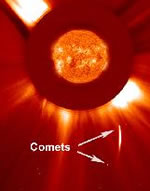
Image credit: SOHO
Comets usually don’t survive an encounter with the Sun, but SOHO captured images of a pair of extremely lucky comets that grazed the surface, well within the Sun’s fiery corona. It’s unusual for comets to travel in pairs like this, but what’s even more unusual is a faint puff of smoke emanating from the Sun at the point of the comets’ closest approach. It’s possible that the Sun evaporated the cloud of ice and dust away from the comets, essentially blasting their heads off. Studying this puff of dust may give astronomers additional clues about the composition of comets.
On May 24, 2003, a pair of comets arced in tandem towards the Sun, their path taking them to just 0.1 solar radii above the Sun’s surface, deep within the searing hot corona.
They belong to the Kreutz family of sun-grazing comets, often seen by SOHO while diving towards their final rendezvous with the Sun. But as in humans, twins are rare! Even more so, this pair showed another very unusual trait: What looks like a faint tail (or “puff of smoke”) can be seen moving away from the Sun, seemingly emanating from a point in the orbit beyond the comet’s closest approach! Normally, sungrazers simply fade and disappear at an earlier stage, obliterated by the intense heat and pressure.
Another pair of Kreutz sungrazers with such a “headless tail” was observed in June 1998 (see MPEG [ 677k] movie), when the observing geometry was very similar. But out of more than 600 sungrazing comets observed during more than six years by SOHO, this is only the third showing any signs of such behaviour!
The puff is most likely the dusty remains of the comet’s nucleus, being pushed out by the radiation pressure after all the ice in the nucleus has evaporated, thus eliminating the processes maintaining a bright coma surrounding the core. Studies of the dust cloud may reveal clues to the size distribution of the dust grains.
Comets are balls of dust and ice that zoom around space in elongated orbits. Their dust tails are pushed by the radiation pressure from the Sun. Their ion tails (usually fainter) are pushed away from the Sun by the solar wind. Both tails point away from the Sun, even for comets that are travelling back outwards in the solar system.
Original Source: SOHO News Release
